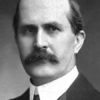William Henry Bragg

William Henry Bragg
Sir William Henry Bragg OM KBE PRSwas a British physicist, chemist, mathematician and active sportsman who uniquely shared a Nobel Prize with his son William Lawrence Bragg – the 1915 Nobel Prize in Physics: "for their services in the analysis of crystal structure by means of X-rays". The mineral Braggite is named after him and his son. He was knighted in 1920...
NationalityBritish
ProfessionPhysicist
Date of Birth2 July 1862
atoms builder constructs kinds limited nature
Let us think of Nature as a builder, making all that we see out of atoms of a limited number of kinds, just as the builder of a house constructs it out of so many different kinds of things: bricks, slates, planks, panes of glass, and so on.
atom chain gas handed movement pass quicker sound workers
Sound is a movement which is handed on from atom to atom in a gas through which the sound is passing, just as a chain of workers pass buckets of water to a fire. The quicker the workers move their hands and arms, the quicker the water moves.
atoms discovery increased individual ten thousand vision
Broadly speaking, the discovery of X-rays has increased the keenness of our vision ten thousand times, and we can now 'see' the individual atoms and molecules.
atoms enter far fast great hands hold meet motion pace sort time vain
In a gas, motion has the upper hand; the atoms are moving so fast that they have no time to enter into any sort of combination with each other: occasionally, atom must meet atom and, so to speak, each hold out vain hands to the other, but the pace is too great and, in a moment, they are far away from each other again.
atoms expression materials molecules properties solid strength tied variety ways
The infinite variety in the properties of the solid materials we find in the world is really the expression of the infinite variety of the ways in which the atoms and molecules can be tied together, and of the strength of those ties.
atoms combined compared form letters variety ways
The atoms may be compared to the letters of the alphabet, which can be put together into innumerable ways to form words. So the atoms are combined in equal variety to form what are called molecules.
concerned discuss forms found gives methods necessary older particular rarely rather science shapes whose
The chemist, whose science is immediately concerned with the combinations of atoms, has rarely found it necessary to discuss their shapes, and gives them no particular forms in his diagrams. That does not mean that the shapes are unimportant, but rather that the older methods could not define them.
atoms gas liquid molecules move partners though whereas
The difference between a gas and a liquid is that in the former, the atoms and molecules move to and fro in an independent existence, whereas in the latter, they are always in touch with one another, though they are changing partners continually.
christian moving writing
Science is experimental, moving forward step-by-step, making trial and learning through success and failure. Is not this also the way of religion, and especially of the Christian religion? The writings of those who preach the religion have from the very beginning insisted that it is to be proved by experience. If a man is drawn towards honour and courage and endurance, justice, mercy, and charity, let him follow the way of Christ and find out for himself. No findings in science hinder him in that way.